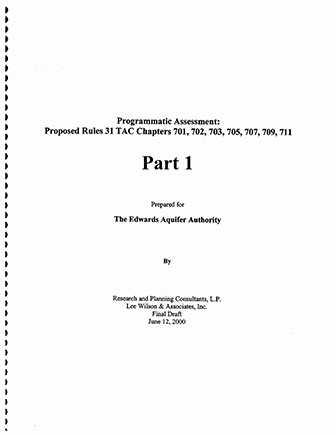Programmatic Assessment: Proposed Rules 31 TAC Chapters 701, 702, 703, 705, 707, 709, 711 – Part 1

| Author | Research and Planning Consultants, LP (RPC) and Lee Wilson & Associates, Inc (LWA) |
| Year | 2000 |
| Description | Part 1 of report on interviews of stakeholders and analysis of how to implement the Edwards Authority Act |
| Publisher | Research and Planning Consultants, LP and Lee Wilson & Associates, Inc |
| Location | EAA geographical jurisdiction |
| Cover | View Download |
| File | View Download |
| Summary |
|
[from the Executive Summary] In 1993, the Texas Legislature passed the Edwards Authority Act (“the Act”), which created the Edwards Aquifer Authority (“EAA”, or “Authority”). The Act mandates that the Authority restrict and reduce the withdrawals of groundwater from the Edwards Aquifer, which is the primary water supply for more than 1.5 million Texans in and near San Antonio. The primary aim of the Act is to ensure that the region complies with the federal Endangered Species Act, a law that protects endangered and threatened species that rely on aquifer-fed spring flows for their habitat. The Authority’s initial rules will limit permitted withdrawals to 450,000 acre-feet per year (AFY), which is less than needed for existing and future municipal, industrial, and irrigation purposes . The Authority is in the process of adopting rules to implement the Act. Under Texas law, the Authority must complete several assessments specified in the Government Code. The assessments are intended to help the Authority to choose among policy options and to disclose the effects of the rules to the public. This report is a Programmatic Assessment of the initial rules prepared by the Authority’s Rules Assessment Team. The Authority invites the public to review and comment on this document so the Authority’s Board of Directors can make decisions based on the best available information…. In making the findings contained in the Programmatic Assessment and reported in this Executive Summary, the Assessment Team interviewed representatives from major stakeholder groups, used quantitative models to estimate certain economic and environmental effects, and evaluated regulatory alternatives…. The principal direct effects of the proposed rules are: (1) to limit withdrawals from the Edwards Aquifer, which will leave many users (especially municipalities) short of water and therefore facing increased costs to acquire replacement supplies; (2) to increase fees paid by users of Edwards water; and (3) to create a marketplace that will function primarily to cause abandonment, retirement, and transfer of irrigation rights…. |
Search for Documents
Advance Search
Explore EAA's Scientific Reports
- All Reports
- Overview Studies
- Modeling
- Hydrology and Hydrogeology
- History
- Groundwater Recharge, Recharge Zone
- Groundwater Movement
- Geomorphology and Caves
- Weather Modification
- Geology
- Water Use and Conservation
- Geochemistry
- Water Resources Planning and Management
- Floods and Drought
- Water Quality
- Climatology
- Surface Water / Groundwater Relationship
- Biology
- Springs, Groundwater Discharge
- Archaeology
- RZ Protection
- Aquifer Levels
- Remote Sensing
- Precipitation
